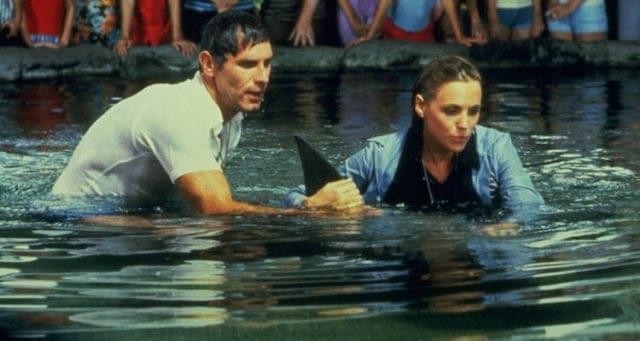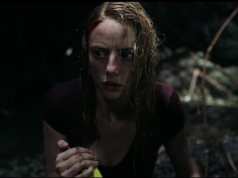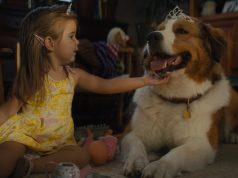
“Jaws” is an entertaining and suspenseful blockbuster from 1975 about a shark that is punished for acting like a shark. The film is very scary. Afterward, many people were afraid to go anywhere near Richard Dreyfuss. This was around the time that Hollywood was getting into lazily titled numbered sequels, so “Jaws 2” came out a few years later. (In the old days, it would have been “The Revenge of Jaws” or “Return to Amity Island” or some such.) When “Jaws 2” proved a financial success, the next course of action was clear: “Jaws 3.” Why, it’s so simple, even a child, or a studio executive, could think of it!
But then something amazing happened. Between “Jaws 2” and “Jaws 3,” Hollywood became re-infatuated with 3-D, a headache-delivery system that requires moviegoers to wear wasteful, uncomfortable glasses in order to see murky images that look vaguely as if they are moving toward the viewer. It was the most popular cinematic gimmick since StabbyChair®, where theater seats were fitted with switchblades that plunged several inches into patrons’ thighs during climactic scenes. As fate would have it, 3-D came into vogue just as the “Jaws” franchise was heading for its third entry. 3-D… “Jaws 3″… a third movie… three dimensions…
OMG, “Jaws 3-D”!!!!!!!!!
Once you’ve got a title like that, the film practically writes itself. Which is what happened, actually. A producer at Universal Pictures set a piece of paper on a conference table with the words “shark attack eat water people 3-D!!!” written on it. When he returned two hours later, the script was finished, having literally written itself. The movie was apparently shot and edited in a similarly miraculous fashion, as no one listed in the credits has any memory of actually making it.
(The credits say the film was “suggested by the novel Jaws by Peter Benchley,” but I doubt Mr. Benchley’s novel made any such suggestion. How could a book “suggest” something, anyway? Books can’t talk! This is stupid.)
The main character in the first two movies, Martin Brody, was played by Roy Scheider, who wanted nothing to do with the third one (or the second one either, for that matter, but that’s another story). Obviously it wouldn’t make any sense for a shark to torment someone not named Brody, so “Jaws 3-D” makes Brody’s sons the targets. Or one of them, anyway. The movie introduces the other son but then forgets about him. The movie was never fully committed to the idea. This is what you get when movies write and produce themselves, unsupervised.
Anyway, we’re at SeaWorld in Orlando, where a new attraction called Undersea Kingdom is about to open. This state-of-the-art facility will take visitors 40 feet below the ocean’s surface and allow them to view sea animals up close from inside tunnels made of unbreakable glass, which will then be broken by a shark. (Spoiler alert.) This man-made lagoon connects to the actual ocean, thus permitting free, non-enslaved animals to come and go, which is obviously a brilliant idea that cannot possibly go wrong.
One of the construction engineers is Mike Brody (Dennis Quaid), who holds no grudge against aquatic animals for causing him so much childhood trauma. The same cannot be said for his brother, Sean (John Putch), who hates the ocean so much that he has moved to Colorado, a state known for its lack of oceans. But he has come to Florida to visit Mike, temporarily casting aside the reasons he has for avoiding the water, and the reasons everyone has for avoiding Florida in general. Upon arriving, Sean meets and hooks up with a SeaWorld water skier named Kelly (Lea Thompson), whereupon they disappear from the movie for a while, coming back near the end just long enough for Kelly to be mildly injured by a shark, whereupon they disappear for good, never to be seen or mentioned again. In fact, I believe this column marks the first time anyone has ever written about either of these characters.
But back to the characters who are important, at least under certain loose definitions of the word “important.” Mike’s girlfriend is Kate (Bess Armstrong), a marine biologist who trains the park’s dolphins. These dolphins are the gregarious, chattering kind that the media is always foisting upon us, the type that warn humans of danger and are lovable, perfect creatures. Frankly, I’m sick of this pro-dolphin propaganda being shoved down my throat everywhere I look, and I think Mike is, too. He’s jealous of the time Kate spends with her underwater friends, derisively calling them “fish” even though he knows they’re really reptiles.
So one of the employees gets killed by a shark that has somehow managed to swim into the lagoon. This fact is discovered when the man’s severed head floats past a window in the Undersea Kingdom tunnel. (As alarming as this is, you have to admit it’s less horrifying than It’s a Small World.) Immediately the other elements of the formulaic story fall into place. The park’s owner, Calvin Bouchard (Louis Gossett Jr.), fills the role of Rich Guy Who Doesn’t Understand Science or Nature, He Only Cares About His Bottom Line, Dammit. He has brought in Philip FitzRoyce (Simon MacCorkindale), a rakish European thrill-seeker whose plan is to find the shark and kill it, live on camera, for all the world to see. FitzRoyce thus occupies the role of Arrogant Adventurer Who Thinks He’s Smarter Than Nature and Will Eventually Be Eaten By It (Nature, I Mean).
Bouchard loves the idea of killing the shark on camera, as it will bring an enormous amount of publicity to SeaWorld. If you think about it, this is akin to a doctor intentionally letting a patient die because it will bring a lot of publicity to the hospital. But Bouchard doesn’t think about it. Slaughtering a giant fish on SeaWorld property is exactly what SeaWorld’s stockholders want to see! Fortunately, Kate talks him out of it, pointing out that they’d get even MORE publicity, and it would last longer, if they CAUGHT the shark, since there are no Great White Sharks in captivity. It’s like the old adage: kill a fish, feed the media for a day. Capture a fish and put it in a tank, feed the media until the fish dies.
They capture the Great White, which is about nine feet long, not particularly big as far as giant sharks in “Jaws” movies go. Kate, being a marine biologist, is very concerned about the shark’s well-being. “Let’s not do anything that’s going to traumatize him,” she says, evidently excluding being tranquilized and captured from the list of potential traumas. While the shark is recovering from the ordeal, Kate and one of her lackeys walk around with it in a shallow pool, keeping it moving so it doesn’t die. Mike thinks this looks fun, so he gets in, too, and then the shark wakes up and thrashes around and nearly bites everyone, ha ha. How does a kid who grew up seeing shark-related deaths every summer on Amity Island develop such a cavalier attitude toward sharks? He’s like the child of abusive alcoholics who now owns a bar.
Bouchard, eager to capitalize on the captive shark, puts it on display immediately, even though it’s still weak and hasn’t adjusted to captivity yet, and it promptly dies, right in front of a crowd of SeaWorld patrons. So Kate and FitzRoyce both got their wishes, I guess. Problem is, now the shark’s mother is VERY ANGRY. The shark’s mother is 35 feet long, the traditional size of monster sharks in movies, and she is STEAMED. She invades the lagoon and smashes into the unbreakable glass and floods the tunnel and scares customers and so forth. As foretold by ancient prophets, she succeeds in eating FitzRoyce, leaving his arm dangling out of her mouth, a grenade still clutched in his fingers. Mike — who it turns out is the hero? I guess? — pulls the pin, swims away with Kate, and the shark goes kabluey, in 3-D. Bits of the shark are propelled at the viewer in a way that probably looked pretty fake in 3-D but looks even worse on 2-D DVD.
That’s the drawback of movies that rely on visual effects to compensate for their weak stories, of course. When you watch them at home, those gimmicks are stripped away. You’re left with a dumb story about boring people who harass sharks, or blue monkey-cats who plug their tails into trees, or whatever. Still, “Jaws 3-D” is better than its sequel, “Jaws 4-D,” which required viewers to travel through time AND wear annoying glasses.
— Film.com





